Vehicular Emission Inventory and Reduction Scenario Analysis in the Yangtze River Delta, China
Abstract
1. Introduction
2. Methodology
2.1. Emission Estimates
2.1.1. Vehicle Population
2.1.2. Vehicle Kilometers Travelled (VKT)
2.1.3. Emission Factors
2.2. Design of Reduction Scenarios
2.2.1. Calculating Energy Consumption
2.2.2. Calculating Pollutant Emissions
3. Results and Discussion
3.1. Vehicular Emission Inter-Annual Trends for Different Pollutants
3.2. Reduction Effects of Different Control Scenarios
3.3. Uncertainty Evaluation
4. Conclusions
Supplementary Materials
Author Contributions
Funding
Acknowledgments
Conflicts of Interest
Nomenclature
| NMVOC | non-methane volatile organic compounds |
| GHG | greenhouse gases |
| PM | particulate matter |
| YRD | Yangtze River Delta |
| GDP | gross domestic product |
| PC | passenger car |
| BUS | bus |
| LDV | light-duty vehicle |
| HDT | heavy-duty truck |
| MC | motorcycle |
| COPERT | Computer Programme to Calculate Emissions from Road Transport |
| BAU | business as usual |
| HSR | high standard replacement |
| RFS | raising fuel standards |
| ESV | elimination of substandard vehicles |
| PTP | public transport priority |
| AER | alternative energy replacement |
| CAER | conservative alternative energy replacement |
| RAER | radical alternative energy replacement |
| EMC | elimination of motorcycles |
| IS | integrated scenario |
| CIS | conservative integrated scenario |
| RIS | radical integrated scenario |
| VKT | vehicle kilometers travelled |
| GREET | Greenhouse Gases, Regulated Emissions, and Energy Use in Transportation |
| WTT | well-to-tank |
| TTW | tank-to-wheels |
References
- Kapadia, Z.Z.; Spracklen, D.V.; Arnold, S.R.; Borman, D.J.; Mann, G.W.; Pringle, K.J.; Monks, S.A.; Reddington, C.L.; Benduhn, F.; Rap, A.; et al. Impacts of aviation fuel sulfur content on climate and human health. Atmos. Chem. Phys. 2016, 16, 10521–10541. [Google Scholar] [CrossRef]
- Lang, J.L.; Tian, J.J.; Zhou, Y.; Li, K.H.; Chen, D.S.; Huang, Q.; Xing, X.F.; Zhang, Y.Y.; Cheng, S.Y. A high temporal-spatial resolution air pollutant emission inventory for agricultural machinery in China. J. Clean. Prod. 2018, 183, 1110–1121. [Google Scholar] [CrossRef]
- Zhang, Q.; Jiang, X.J.; Tong, D.; Davis, S.J.; Zhao, H.Y.; Geng, G.N.; Feng, T.; Zheng, B.; Lu, Z.F.; Streets, D.G.; et al. Transboundary health impacts of transported global air pollution and international trade. Nature 2017, 543, 705–709. [Google Scholar] [CrossRef] [PubMed]
- Lv, W.D.; Hu, Y.L.; Li, E.P.; Liu, H.Q.; Pan, H.; Ji, S.P.; Hayat, T.; Alsaedi, A.; Ahmad, B. Evaluation of vehicle emission in Yunnan province from 2003 to 2015. J. Clean. Prod. 2019, 207, 814–825. [Google Scholar] [CrossRef]
- Zheng, B.; Zhang, Q.; Borken-Kleefeld, J.; Huo, H.; Guan, D.; Klimont, Z.; Peters, G.P.; He, K. How will greenhouse gas emissions from motor vehicles be constrained in China around 2030. Appl. Energy 2015, 156, 230–240. [Google Scholar] [CrossRef]
- Sun, S.D.; Zhao, G.; Wang, T.; Jin, J.X.; Wang, P.; Lin, Y.C.; Li, H.B.; Ying, Q.; Mao, H.J. Past and future trends of vehicle emissions in Tianjin, China, from 2000 to 2030. Atmos. Environ. 2019, 209, 182–191. [Google Scholar] [CrossRef]
- He, J.; Wu, L.; Mao, H.; Liu, H.; Jing, B.; Yu, Y.; Ren, P.; Feng, C.; Liu, X. Development of a vehicle emission inventory with high temporal-spatial resolution based on NRT traffic data and its impact on air pollution in Beijing - Part 2: impact of vehicle emission on urban air quality. Atmos. Chem. Phys. 2016, 16, 3171–3184. [Google Scholar] [CrossRef]
- Winther, M.; Nielsen, O.K. Technology dependent BC and OC emissions for Denmark, Greenland and the Faroe Islands calculated for the time period 1990–2030. Atmos. Environ. 2011, 45, 5880–5895. [Google Scholar] [CrossRef]
- Kota, S.; Zhang, H.; Chen, G.; Schade, G.W.; Ying, Q. Evaluation of on-road vehicle CO and NOx national emission inventories using an urban-scale source-oriented air quality model. Atmos. Environ. 2014, 85, 99–108. [Google Scholar] [CrossRef]
- Fameli, K.M.; Assimakopoulos, V.D. Development of a road transport emission inventory for Greece and the Greater Athens Area: effects of important parameters. Sci. Total Environ. 2015, 505, 770–786. [Google Scholar] [CrossRef]
- Alam, M.S.; Hyde, B.; Duffy, P.; McNabola, S. Assessment of pathways to reduce CO2 emissions from passenger car fleets: Case study in Ireland. Appl. Energy 2017, 189, 283–300. [Google Scholar] [CrossRef]
- Ibarra-Espinosa, S.; Ynoue, R.; O’Sullivan, S.; Pebesma, E.; Andrade, M.D.F.; Osses, M. VEIN v0.2.2: An R Package for Bottom–Up Vehicular Emissions Inventories. Geosci. Model Dev. 2018, 11, 2209–2229. [Google Scholar] [CrossRef]
- Perugu, H. Emission modelling of light-duty vehicles in India using the revamped VSP-based MOVES model: The case study of Hyderabad. Transp. Res. Part D Transp. Environ. 2019, 68, 150–163. [Google Scholar] [CrossRef]
- Lang, J.L.; Cheng, S.Y.; Wei, W.; Zhou, Y.; Wei, X.; Chen, D.S. A study on the trends of vehicular emissions in the Beijing-Tianjin-Hebei (BTH) region, China. Atmos. Environ. 2012, 62, 605–614. [Google Scholar] [CrossRef]
- Liu, Y.H.; Liao, W.Y.; Lin, X.F.; Li, L.; Zeng, X.L. Assessment of Co-benefits of vehicle emission reduction measures for 2015–2020 in the Pearl River Delta region, China. Environ. Pollut. 2017, 223, 62–72. [Google Scholar] [CrossRef]
- Guo, X.R.; Fu, L.W.; Ji, M.S.; Lang, J.L.; Chen, D.S.; Cheng, S.Y. Scenario analysis to vehicular emission reduction in Beijing-Tianjin-Hebei (BTH) region, China. Environ. Pollut. 2016, 216, 470–479. [Google Scholar] [CrossRef]
- National Bureau of Statistics of China (NBSC). International Statistical Yearbook; China Statistics Press: Beijing, China, 2000–2016. [Google Scholar]
- Deng, J.J. Study on the Formation Mechanism and Forecasting Methodology on Haze Weather in Yangtze River Delta. Ph.D. Thesis, Nanjing University, Jiangsu, China, 2011. (In Chinese). [Google Scholar]
- Song, X.W.; Hao, Y.P.; Zhang, C.; Peng, J.T.; Zhu, X.D. Vehicular emission trends in the Pan-Yangtze River Delta in China between 1999 and 2013. J. Clean. Prod. 2016, 137, 1045–1054. [Google Scholar] [CrossRef]
- Wang, J.L. Study and Evaluation on Pollution Characteristics and Control Policies of Motor Vehicles in the Yangtze River Delta Region. Master’s Thesis, Zhejiang University, Hangzhou, China, 2018. (In Chinese). [Google Scholar]
- National Bureau of Statistics of Anhui (NBSA). Anhui Statistical Yearbook; China Statistics Press: Beijing, China, 2000–2016. [Google Scholar]
- National Bureau of Statistics of Jiangsu (NBSJ). Jiangsu Statistical Yearbook; China Statistics Press: Beijing, China, 2000–2016. [Google Scholar]
- National Bureau of Statistics of Shanghai (NBSS). Shanghai Statistical Yearbook; China Statistics Press: Beijing, China, 2000–2016. [Google Scholar]
- National Bureau of Statistics of Zhejiang (NBSZ). Zhejiang Statistical Yearbook; China Statistics Press: Beijing, China, 2000–2016. [Google Scholar]
- Huo, H.; Zhang, Q.; He, K.B.; Yao, Z.L.; Wang, X.T.; Zheng, B.; Streets, D.G.; Wang, Q.D.; Ding, Y. Modeling vehicle emissions in different types of Chinese cities: importance of vehicle fleet and local features. Environ. Pollut. 2011, 159, 2954–2960. [Google Scholar] [CrossRef]
- Wang, H.K.; Fu, L.X.; Zhou, Y.; Du, X.; Ge, W.H. Trends in vehicular emissions in China’s mega cities from 1995 to 2005. Environ. Pollut. 2010, 158, 394–400. [Google Scholar] [CrossRef]
- Sun, S.D.; Jiang, W.; Gao, W.D. Vehicle emission trends and spatial distribution in Shandong province, China, from 2000 to 2014. Atmos. Environ. 2016, 147, 190–199. [Google Scholar] [CrossRef]
- Lang, J.L.; Cheng, S.Y.; Zhou, Y.; Zhang, Y.L.; Wang, G. Air pollutant emissions from on-road vehicles in China, 1999–2011. Sci. Total Environ. 2014, 496, 1–10. [Google Scholar] [CrossRef]
- Hao, H.; Wang, H.; Ouyang, M.; Cheng, F. Vehicle survival patterns in China. Sci. China Technol. Sci. 2011, 54, 625–629. (In Chinese) [Google Scholar] [CrossRef]
- Huo, H.; Wang, M. Modeling future vehicle sales and stock in China. Energy Policy 2012, 43, 17–29. [Google Scholar] [CrossRef]
- Dargay, J.; Gatel, Y.D. Vehicle ownership to 2015: implication for energy use and emission. Energy Policy 1997, 25, 1121–1127. [Google Scholar] [CrossRef]
- Dargay, J.; Gatel, Y.D. Income’s effect on car and vehicle ownership, worldwide: 1960–2015. Transport. Res. A Pol. 1999, 33, 101–138. [Google Scholar] [CrossRef]
- Ji, M.S.; Guo, X.R.; Lang, J.L.; Cheng, D.S. Scenario prediction of motor vehicle emission and control in megacities. Res. Environ. Sci. 2013, 26, 919–928. (In Chinese) [Google Scholar]
- He, K.B.; Huo, H.; Zhang, Q.; He, D.Q.; An, F.; Wang, M.; Walsh, M.P. Oil consumption and CO2 emissions in China’s road transport: current status, future trends, and policy implications. Energy Policy 2005, 33, 1499–1507. [Google Scholar] [CrossRef]
- Cai, H.; Xie, S.D. Estimation of vehicular emission inventories in China from 1980 to 2005. Atmos. Environ. 2007, 41, 8963–8979. [Google Scholar] [CrossRef]
- Hu, D.F. Research on Pollution Characteristic of Vehicle Exhausts in Ningbo and Its Prevention Measurement. Master’s Thesis, Zhejiang University, Hangzhou, China, 2008. (In Chinese). [Google Scholar]
- Lin, X.L.; Tang, D.G.; Ding, Y.; Yin, H.; Ji, Z. Study on the distribution of vehicle mileage traveled in China. Res. Environ. Sci. 2009, 22, 377–380. (In Chinese) [Google Scholar]
- Lu, Q.; Zheng, J.Y.; Ye, S.Q.; Shen, X.L.; Yuan, Z.B.; Yin, S.S. Emission trends and source characteristics of SO2, NOx, PM10 and VOCs in the Pearl River Delta region from 2000 to 2009. Atmos. Environ. 2013, 76, 11–20. [Google Scholar] [CrossRef]
- Huo, H.; Zhang, Q.; He, K.B.; Yao, Z.L.; Wang, M. Vehicle-use intensity in China: current status and future trend. Energy. Policy 2012, 43, 6–16. [Google Scholar] [CrossRef]
- Wang, H.K.; Fu, L.X.; Lin, X.; Zhou, Y.; Chen, J.C. A bottom-up methodology to estimate vehicle emissions for the Beijing urban area. Sci. Total Environ. 2009, 407, 1947–1953. [Google Scholar] [CrossRef] [PubMed]
- Li, X.X.; Sun, G.J.; Tian, W.L.; Zhang, Q.Y. Study on abatement policy of NOx emission from vehicles in Hangzhou during 12th Five-Year Plan. China Environ. Sci. 2012, 32, 1416–1421. (In Chinese) [Google Scholar]
- Tian, J. Atmospheric Environment Impact Assessment of Mobile Source and Vehicle Control Strategies in Nanjing. Master’s Thesis, Nanjing University, Jiangsu, China, 2013. (In Chinese). [Google Scholar]
- China Meterological Administration (CMA). China Meteorological Yearbook; Meteorological Press: Beijing, China, 2000–2016. [Google Scholar]
- Wang, C. Characteristics and Prediction Research of Automobile Emissions in Shandong Province Based on COPERT4 Model. Master’s Thesis, Ocean University of China, Qingdao, China, 2015. (In Chinese). [Google Scholar]
- Cai, H.; Xie, S.D. Determination of emission factors from motor vehicles under different emission standards in China. Acta Sci. Nat. Univ. Pekin. 2010, 46, 319–326. (In Chinese) [Google Scholar]
- Che, W.W. A Highly Resolved Mobile Sorce Emission Inventory in the Pearl River Delta and Assessment of Motor Vehicle Pollution Control Strategies. Master’s Thesis, South China University of Technology, Guangdong, China, 2010. (In Chinese). [Google Scholar]
- Zhang, S.J. Characteristics and Control Strategies of Vehicle Emissions in Typical Cities of China. Ph.D. Thesis, Tsinghua University, Beijing, China, 2014. (In Chinese). [Google Scholar]
- Tao, S.C. Emission Inventory and Control Strategies of Road Mobile Sources in Guanzhong Metropolitan Area. Master’s Thesis, Chang’an University, Xi’an, China, 2016. (In Chinese). [Google Scholar]
- Lumbreras, J.; Valdés, M.; Borge, R.; Rodriguez, M.E. Assessment of vehicle emissions projections in Madrid (Spain) from 2004 to 2012 considering several control strategies. Transp. Res. Part A 2008, 42, 646–658. [Google Scholar]
- Liu, H.; Wang, H.W.; Luo, Q.; Wang, Y.; Ouyang, M.G. Energy, environmental and economic assessment of life cycle for electric vehicle. Technol. Econ. Areas Commun. 2007, 9, 45–48. (In Chinese) [Google Scholar]
- Song, G.H.; Yu, L.; Mo, F.; Zhang, X. A comparative experimental study on the emissions of HEV and conventional gasoline vehicle. Automot. Eng. 2007, 29, 865–869. (In Chinese) [Google Scholar]
- Zhou, Y.; Wu, Y.; Lin, B.H.; Wang, R.J.; Fu, L.X.; Hao, J.M. Assessment of the environmental effects if the compressed natural gas bus fleet in Beijing. Acta Sci. Circ. 2010, 30, 1921–1925. (In Chinese) [Google Scholar]
- Li, S.H. Life Cycle Assessment and Environmental Benefits Analysis of Electric Vehicles. Ph.D. Thesis, Jilin University, Changchun, China, 2014. (In Chinese). [Google Scholar]
- Yu, M.X. The Emission Ceiling Control of NOx for Light-Duty Vehicles in Three Developed Regions of China. Master’s Thesis, Tsinghua University, Beijing, China, 2014. (In Chinese). [Google Scholar]
- Wang, Z.H.; Liu, W. Determinants of CO2 emissions from household daily travel in Beijing, China, Individual travel characteristic perspectives. Appl. Energy 2015, 158, 292–299. [Google Scholar] [CrossRef]
- Nansai, K.; Tohno, S.; Kono, M.; Kasahara, M. Effects of electric vehicles (EV) on environmental loads with consideration of regional differences of electric power generation and charging characteristic of EV users in Japan. Appl. Energy 2002, 71, 111–125. [Google Scholar] [CrossRef]
- Wang, R.J. Fuel-Cycle Assessment of Energy and Environmental Impacts from Electric Vehicles and Natural Gas Vehicles. Ph.D. Thesis, Tsinghua University, Beijing, China, 2015. (In Chinese). [Google Scholar]
- International Energy Agency (IEA). World Energy Outlook; International Energy Agency: Paris, France, 2013. [Google Scholar]
- Jiang, K.J.; Hu, X.L.; Zhuang, X.; Liu, Q. China’s low-carbon scenarios and roadmap for 2050. Sino-Global Energy 2009, 14, 1–7. (In Chinese) [Google Scholar]
- Ma, M. Development of DeNOx technology in coal-fired power plants. Electr. Power Constr. 2004, 25, 52–55. (In Chinese) [Google Scholar]
- Feng, D.X. Application of denitrification technologies on coal burning boiler in a coal-fired power plant. Electr. Power Environ. Prot. 2005, 21, 23–26. (In Chinese) [Google Scholar]
- Zhao, Y.; Wang, S.X.; Duan, L.; Lei, Y.; Cao, P.F.; Hao, J.M. Primary air pollutant emissions of coal-fired power plants in China: Current status and future prediction. Atmos. Environ. 2008, 42, 8442–8452. [Google Scholar] [CrossRef]
- Chen, W.Y.; Xu, R.N. Clean coal technology development in China. Energy Policy 2010, 38, 2123–2130. [Google Scholar] [CrossRef]
- Wei, W.; Wang, S.X.; Chatani, S.; Klimont, Z.; Cofala, J.; Hao, J.M. Emission and speciation of non-methane volatile organic compounds from anthropogenic sources in China. Atmos. Environ. 2008, 42, 4916–4988. [Google Scholar] [CrossRef]
- Zhao, B.; Wang, S.X.; Dong, X.Y.; Wang, J.D.; Duan, L.; Fu, X.; Hao, J.M.; Fu, J. Environmental effects of the recent emission changes in China: implications for particulate matter pollution and soil acidification. Environ. Res. Lett. 2013, 8, 1–10. [Google Scholar] [CrossRef]
- Zhao, B.; Wang, S.X.; Liu, H.; Xu, J.Y.; Fu, K.; Klimont, Z.; Hao, J.M.; He, K.B.; Cofala, J.; Amann, M. NOx emissions in China: historical trends and future perspectives. Atmos. Chem. Phys. 2013, 13, 9869–9897. [Google Scholar] [CrossRef]
- Wang, S.X.; Zhao, B.; Cai, S.Y.; Klimont, Z.; Nielsen, C.P.; Morikawa, T.; Woo, J.H.; Kim, Y.; Fu, X.; Xu, J.Y.; et al. Emission trends and mitigation options for air pollutants in East Asia. Atmos. Chem. Phys. 2014, 14, 6571–6603. [Google Scholar] [CrossRef]
- Hao, Y.P.; Song, X.W. Research on trends and spatial distribution of vehicular emissions and its control measure assessment in the Yangtze River Delta, China, for 1999–2015. Environ. Sci. Pollut. Res. 2018, 25, 36503–36517. [Google Scholar] [CrossRef]
- Chan, C.K.; Yao, X.H. Air pollution in mega cities in China. Atmos. Environ. 2008, 42, 1–42. [Google Scholar] [CrossRef]
- Behera, S.N.; Sharma, M. Investigating the potential role of ammonia in ion chemistry of fine particulate matter formation for an urban environment. Sci. Total Environ. 2010, 408, 3569–3575. [Google Scholar] [CrossRef] [PubMed]
- Lang, J.L.; Zhou, Y.; Cheng, S.Y.; Zhang, Y.Y.; Dong, M.; Li, S.Y.; Wang, G.; Zhang, Y.L. Unregulated pollutant emissions from on-road vehicles in China, 1999–2014. Sci. Total Environ. 2016, 573, 974–984. [Google Scholar] [CrossRef] [PubMed]
- Kioutsioukis, I.; Tarantola, S.; Saltelli, A.; Gatelli, D. Uncertainty and global sensitivity analysis of road transport emission estimates. Atmos. Environ. 2004, 38, 6609–6620. [Google Scholar] [CrossRef]
- Wang, H.K.; Chen, C.H.; Huang, C.; Fu, L.X. On-road vehicle emission inventory and its uncertainty analysis for Shanghai, China. Sci. Total Environ. 2008, 398, 60–67. [Google Scholar] [CrossRef]
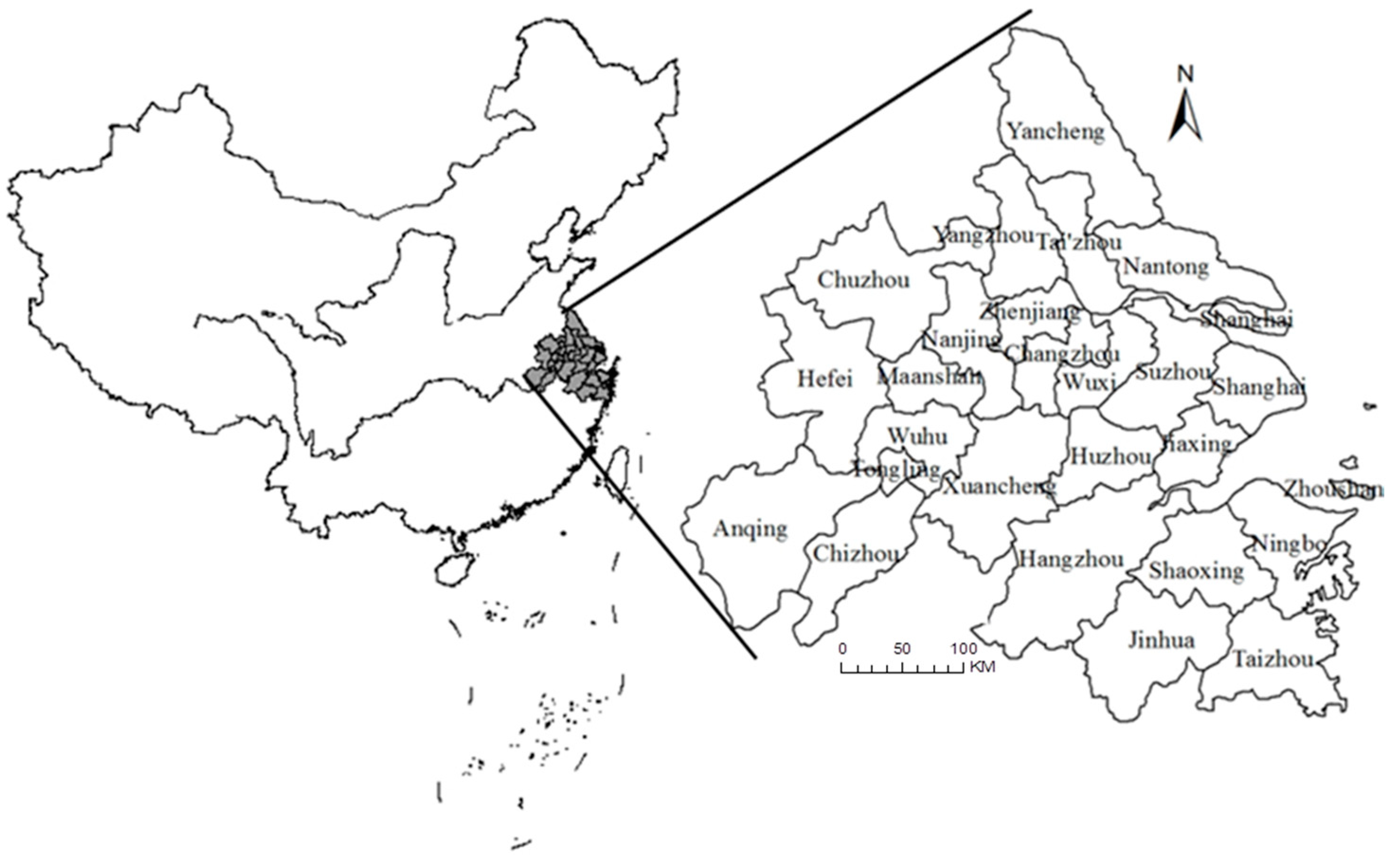
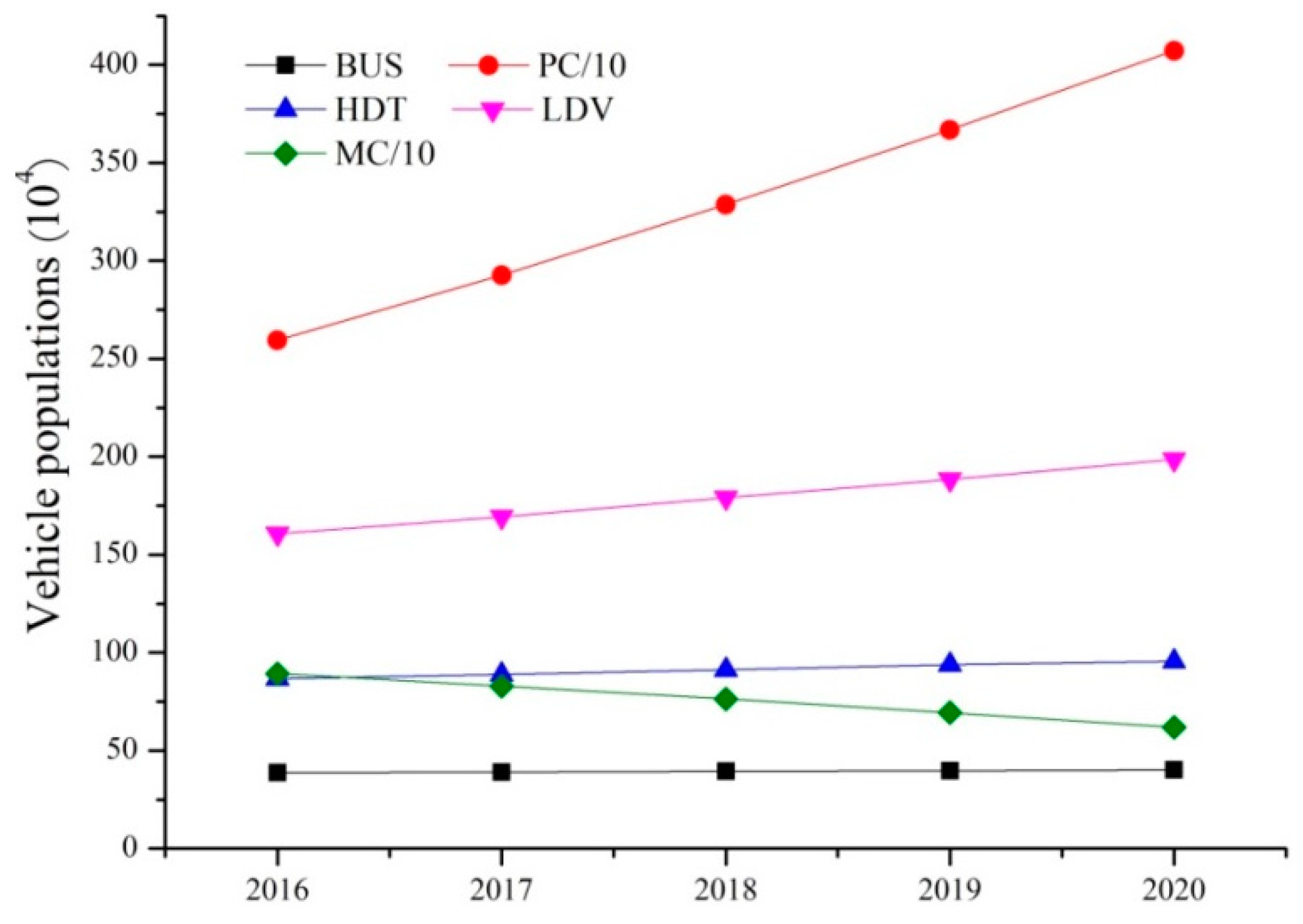
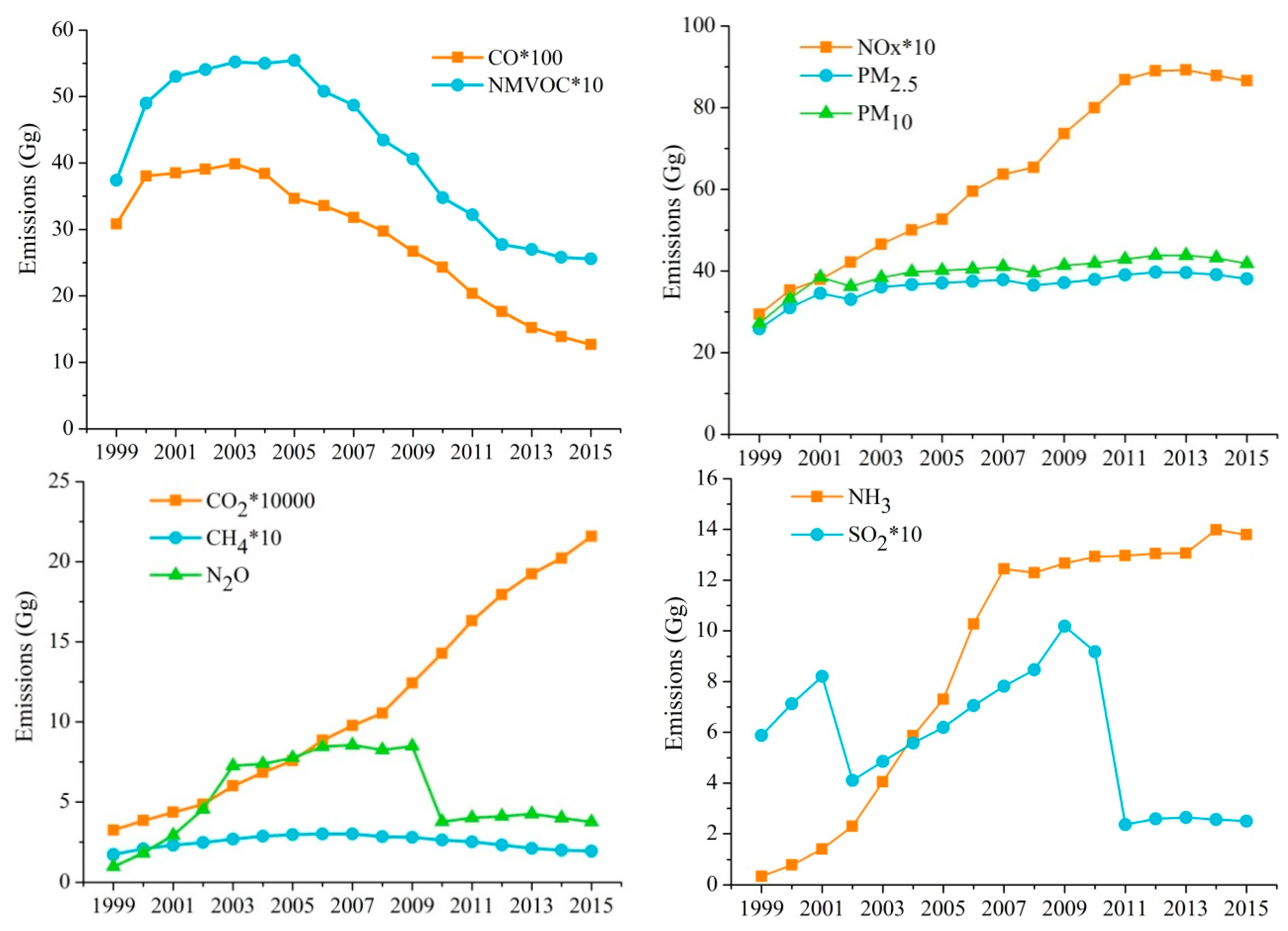
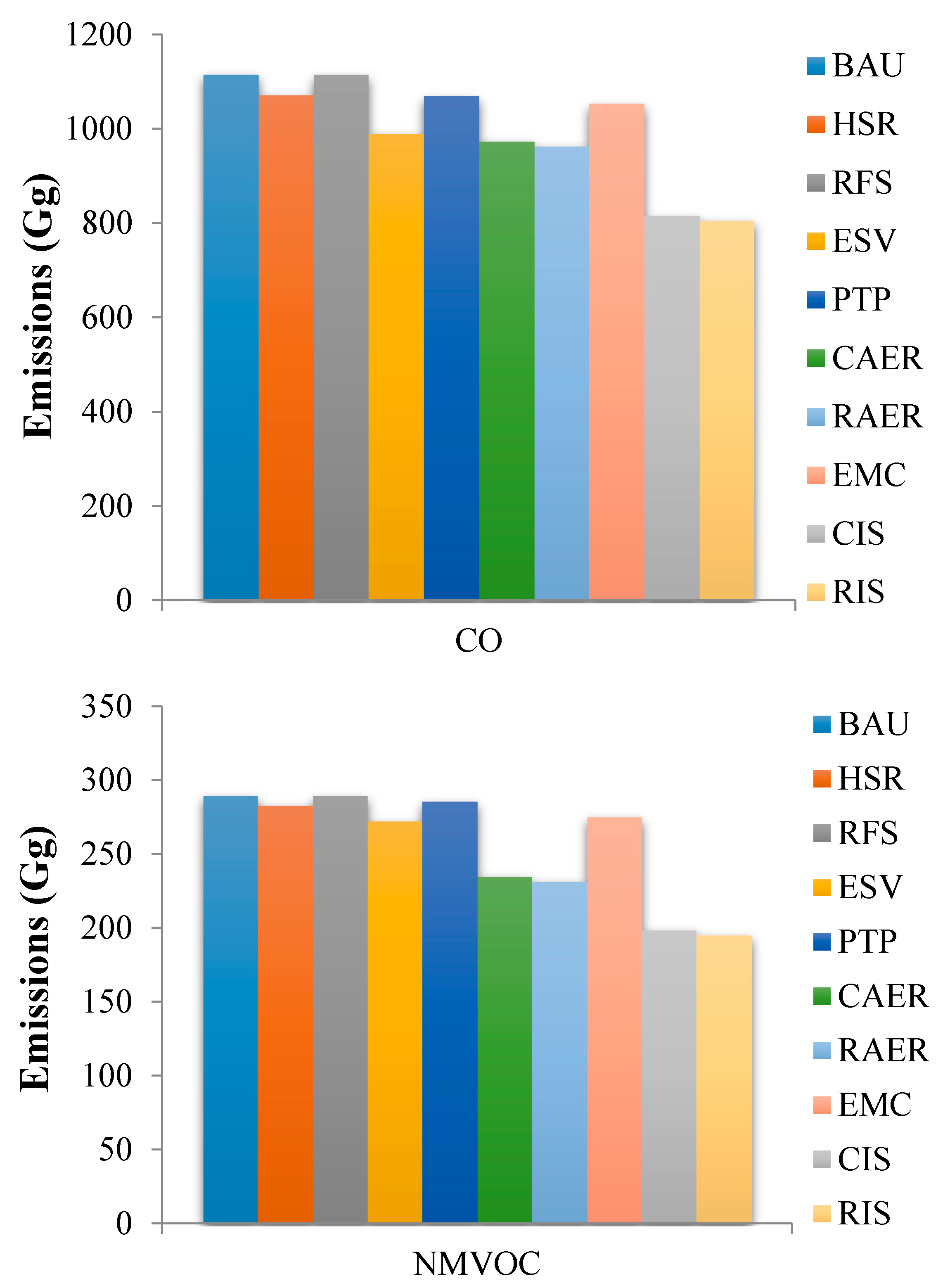
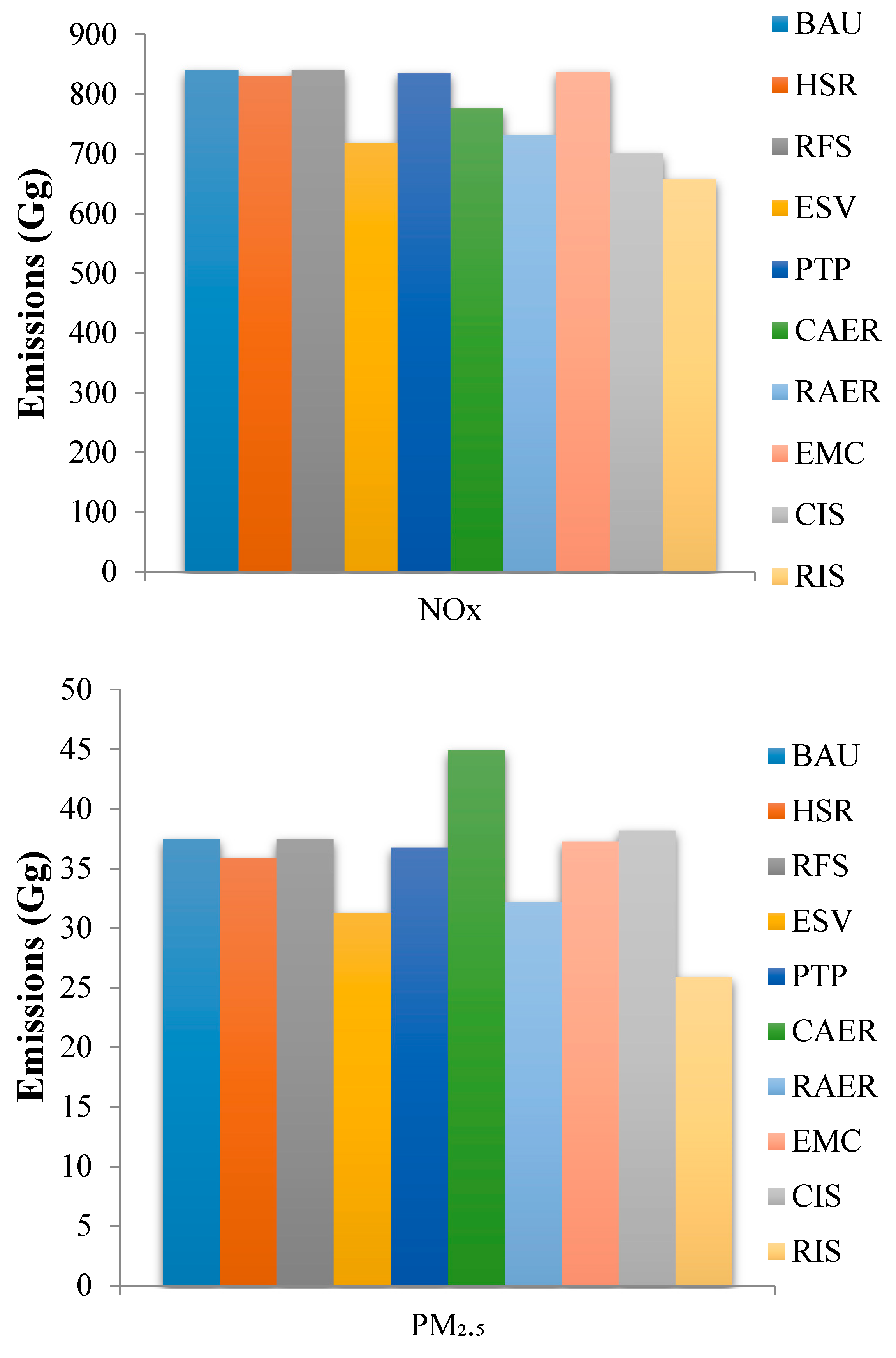

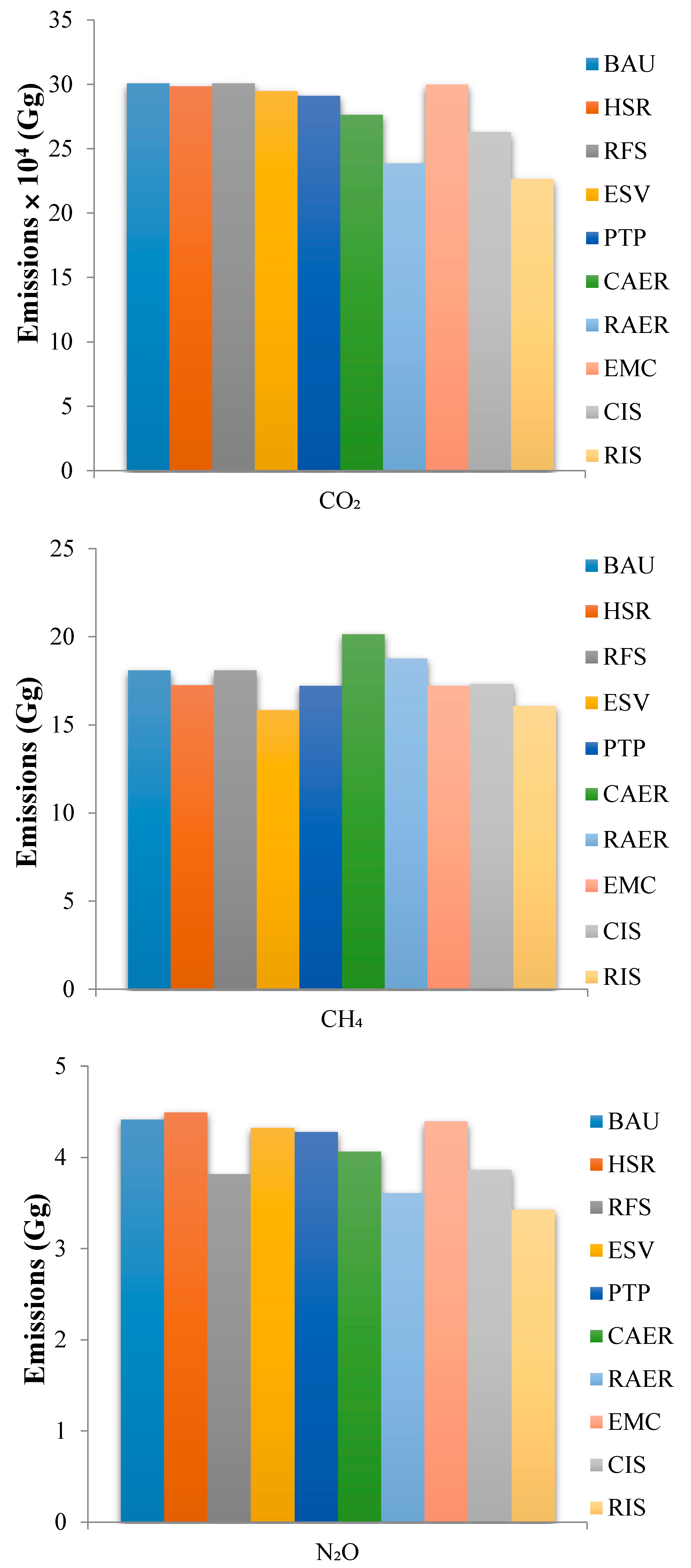
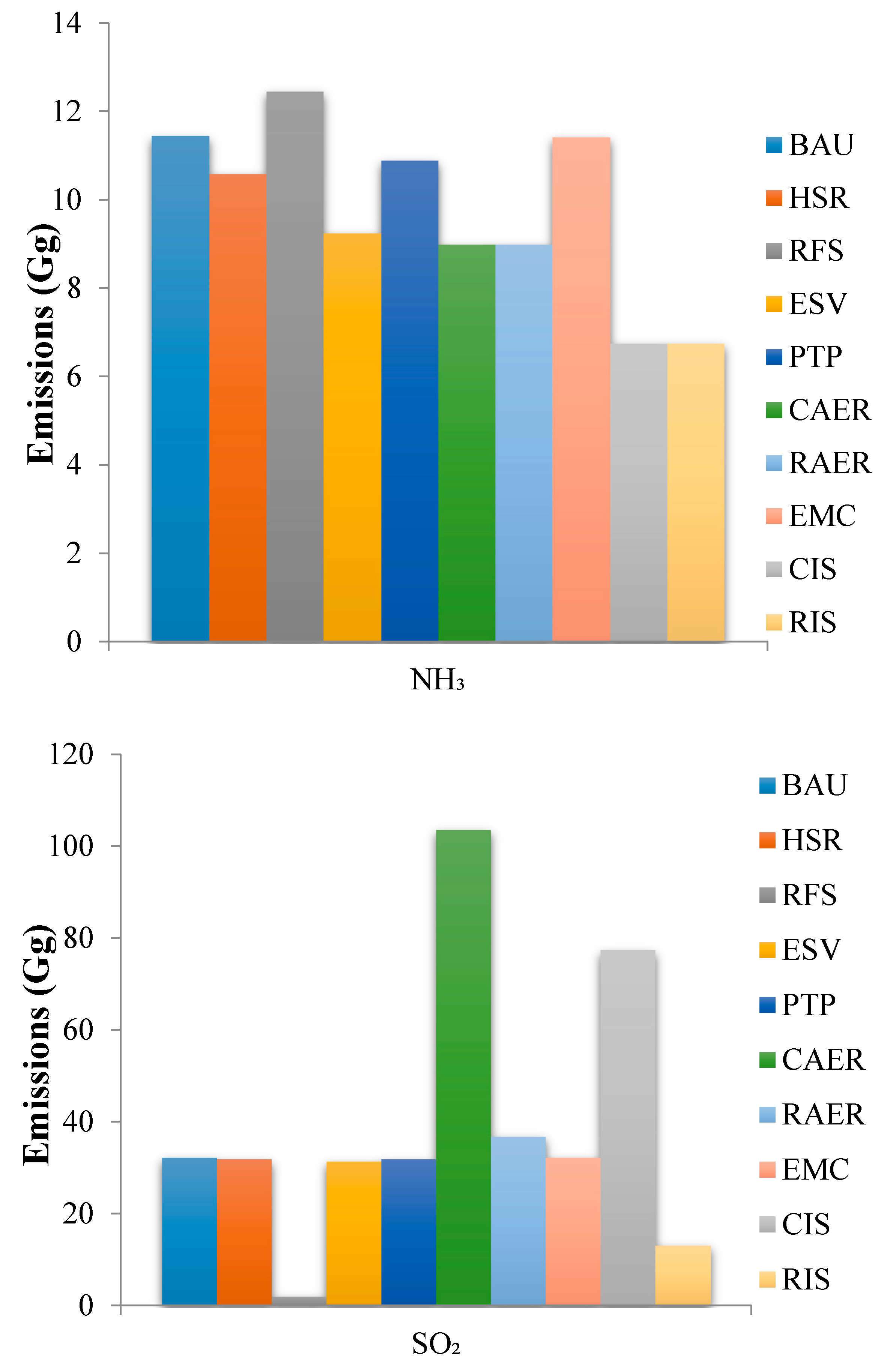
© 2019 by the authors. Licensee MDPI, Basel, Switzerland. This article is an open access article distributed under the terms and conditions of the Creative Commons Attribution (CC BY) license (http://creativecommons.org/licenses/by/4.0/).
Share and Cite
Song, X.; Hao, Y. Vehicular Emission Inventory and Reduction Scenario Analysis in the Yangtze River Delta, China. Int. J. Environ. Res. Public Health 2019, 16, 4790. https://doi.org/10.3390/ijerph16234790
Song X, Hao Y. Vehicular Emission Inventory and Reduction Scenario Analysis in the Yangtze River Delta, China. International Journal of Environmental Research and Public Health. 2019; 16(23):4790. https://doi.org/10.3390/ijerph16234790
Chicago/Turabian StyleSong, Xiaowei, and Yongpei Hao. 2019. "Vehicular Emission Inventory and Reduction Scenario Analysis in the Yangtze River Delta, China" International Journal of Environmental Research and Public Health 16, no. 23: 4790. https://doi.org/10.3390/ijerph16234790
APA StyleSong, X., & Hao, Y. (2019). Vehicular Emission Inventory and Reduction Scenario Analysis in the Yangtze River Delta, China. International Journal of Environmental Research and Public Health, 16(23), 4790. https://doi.org/10.3390/ijerph16234790





